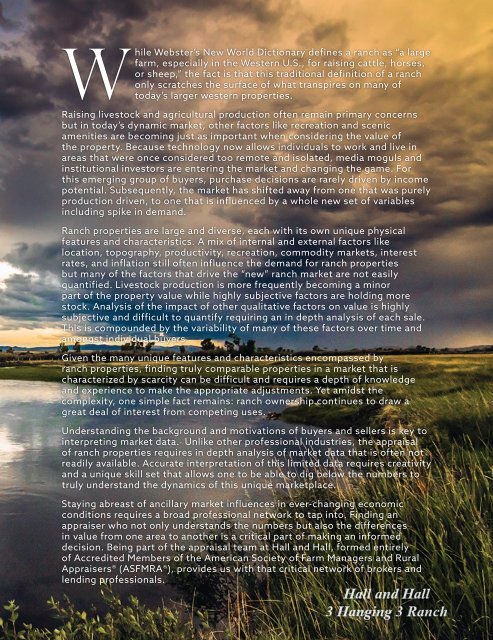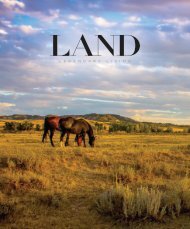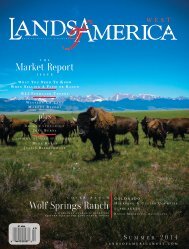Summer 2015
Summer 2015
Summer 2015
Create successful ePaper yourself
Turn your PDF publications into a flip-book with our unique Google optimized e-Paper software.
LAND MAGAZINE // LEGENDARY LIVING COVER RANCH<br />
While Webster’s New World Dictionary defines a ranch as “a large<br />
farm, especially in the Western U.S., for raising cattle, horses,<br />
or sheep,” the fact is that this traditional definition of a ranch<br />
only scratches the surface of what transpires on many of<br />
today’s larger western properties.<br />
Raising livestock and agricultural production often remain primary concerns<br />
but in today’s dynamic market, other factors like recreation and scenic<br />
amenities are becoming just as important when considering the value of<br />
the property. Because technology now allows individuals to work and live in<br />
areas that were once considered too remote and isolated, media moguls and<br />
institutional investors are entering the market and changing the game. For<br />
this emerging group of buyers, purchase decisions are rarely driven by income<br />
potential. Subsequently, the market has shifted away from one that was purely<br />
production driven, to one that is influenced by a whole new set of variables<br />
including spike in demand.<br />
Ranch properties are large and diverse, each with its own unique physical<br />
features and characteristics. A mix of internal and external factors like<br />
location, topography, productivity, recreation, commodity markets, interest<br />
rates, and inflation still often influence the demand for ranch properties<br />
but many of the factors that drive the “new” ranch market are not easily<br />
quantified. Livestock production is more frequently becoming a minor<br />
part of the property value while highly subjective factors are holding more<br />
stock. Analysis of the impact of other qualitative factors on value is highly<br />
subjective and difficult to quantify requiring an in depth analysis of each sale.<br />
This is compounded by the variability of many of these factors over time and<br />
amongst individual buyers.<br />
Given the many unique features and characteristics encompassed by<br />
ranch properties, finding truly comparable properties in a market that is<br />
characterized by scarcity can be difficult and requires a depth of knowledge<br />
and experience to make the appropriate adjustments. Yet amidst the<br />
complexity, one simple fact remains: ranch ownership continues to draw a<br />
great deal of interest from competing uses.<br />
Understanding the background and motivations of buyers and sellers is key to<br />
interpreting market data. Unlike other professional industries, the appraisal<br />
of ranch properties requires in depth analysis of market data that is often not<br />
readily available. Accurate interpretation of this limited data requires creativity<br />
and a unique skill set that allows one to be able to dig below the numbers to<br />
truly understand the dynamics of this unique marketplace.<br />
Staying abreast of ancillary market influences in ever-changing economic<br />
conditions requires a broad professional network to tap into. Finding an<br />
appraiser who not only understands the numbers but also the differences<br />
in value from one area to another is a critical part of making an informed<br />
decision. Being part of the appraisal team at Hall and Hall, formed entirely<br />
of Accredited Members of the American Society of Farm Managers and Rural<br />
Appraisers® (ASFMRA® ), provides us with that critical network of brokers and<br />
lending professionals.<br />
LANDSOFAMERICAMAGAZINES.COM<br />
31
















